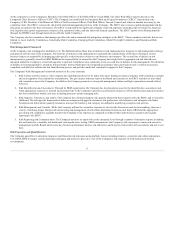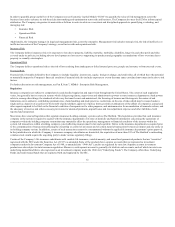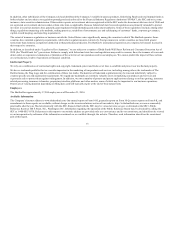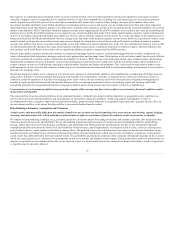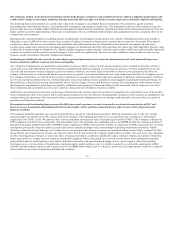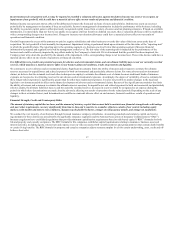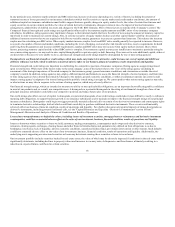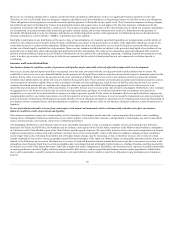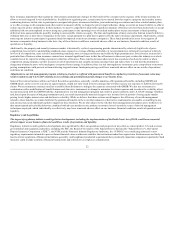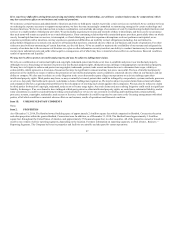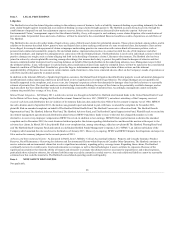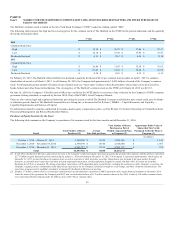The Hartford 2014 Annual Report Download - page 21
Download and view the complete annual report
Please find page 21 of the 2014 The Hartford annual report below. You can navigate through the pages in the report by either clicking on the pages listed below, or by using the keyword search tool below to find specific information within the annual report.
Our liquidity could be constrained by a catastrophe, or multiple catastrophes, which could result in extraordinary losses. In addition, in part because
accounting rules do not permit insurers to reserve for such catastrophic events until they occur, claims from catastrophic events could have a material adverse
effect on our business, financial condition, results of operations or liquidity. To the extent that loss experience unfolds or models improve, we will seek to
reflect any of these changes in the design and pricing of our products. However, the Company may be exposed to regulatory or legislative actions that
prevent a full accounting of loss expectations in the design or pricing of our products or result in additional risk-shifting to the insurance industry.
The occurrence of one or more terrorist attacks in the geographic areas we serve or the threat of terrorism in general may have a material adverse effect on
our business, financial condition, results of operations and liquidity.
The occurrence of one or more terrorist attacks in the geographic areas we serve could result in substantially higher claims under our insurance policies than
we have anticipated. Private sector catastrophe reinsurance is extremely limited and generally unavailable for terrorism losses caused by attacks with nuclear,
biological, chemical or radiological weapons. Reinsurance coverage from the federal government under the Terrorism Risk Insurance Program
Reauthorization Act of 2015 (“TRIPRA”) is also limited. Although TRIPRA provides benefits for certified acts of terrorism that exceed a certain threshold of
industry losses ($100 in 2015, increasing to $200 by 2020), those benefits are subject to a deductible and other limitations. Under TRIPRA, once our losses
exceed 20% of our subject commercial property and casualty insurance premium for the preceding calendar year, the federal government will reimburse us a
percentage of our losses (85% in 2015, decreasing 1% annually until 2020) attributable to certain acts of terrorism which exceed this deductible up to a total
industry program cap of $100 billion. Our estimated deductible under the program is $1.19 billion for 2015. In addition, because the interpretation of this law
is untested, there is substantial uncertainty as to how it will be applied to specific circumstances.
Accordingly, the effects of a terrorist attack in the geographic areas we serve may result in claims and related losses for which we do not have adequate
reinsurance. This would likely cause us to increase our reserves, adversely affect our results during the period or periods affected and, could adversely affect
our business, financial condition, results of operations and liquidity. Further, the continued threat of terrorism and the occurrence of terrorist attacks, as well
as heightened security measures and military action in response to these threats and attacks or other geopolitical or military crises, may cause significant
volatility in global financial markets, disruptions to commerce and reduced economic activity. These consequences could have an adverse effect on the value
of the assets in our investment portfolio as well as those in our separate accounts. Terrorist attacks also could disrupt our operations centers in the U.S. or
abroad. As a result, it is possible that any, or a combination of all, of these factors may have a material adverse effect on our business, financial condition,
results of operations and liquidity.
Our business, financial condition, results of operations and liquidity may be adversely affected by the emergence of unexpected and unintended claim and
coverage issues.
As industry practices and legal, judicial, social and other environmental conditions change, unexpected and unintended issues related to claims and coverage
may emerge. These issues may either extend coverage beyond our underwriting intent or increase the frequency or severity of claims. In some instances, these
changes may not become apparent until some time after we have issued insurance contracts that are affected by the changes. As a result, the full extent of
liability under our insurance contracts may not be known for many years after a contract is issued, and this liability may have a material adverse effect on our
business, financial condition, results of operations and liquidity at the time it becomes known
As a property and casualty insurer, the premium rates we are able to charge and the profits we are able to obtain are affected by the actions of state
insurance departments that regulate our business, the cyclical nature of the business in which we compete and our ability to adequately price the risks we
underwrite, which may have a material adverse effect on our business, financial condition, results of operations and liquidity.
Pricing adequacy depends on a number of factors, including the ability to obtain regulatory approval for rate changes, proper evaluation of underwriting
risks, the ability to project future loss cost frequency and severity, our response to rate actions taken by competitors, and expectations about regulatory and
legal developments and expense levels. We seek to price our property and casualty insurance policies such that insurance premiums and future net
investment income earned on premiums received will provide for an acceptable profit in excess of underwriting expenses and the cost of paying claims.
21


